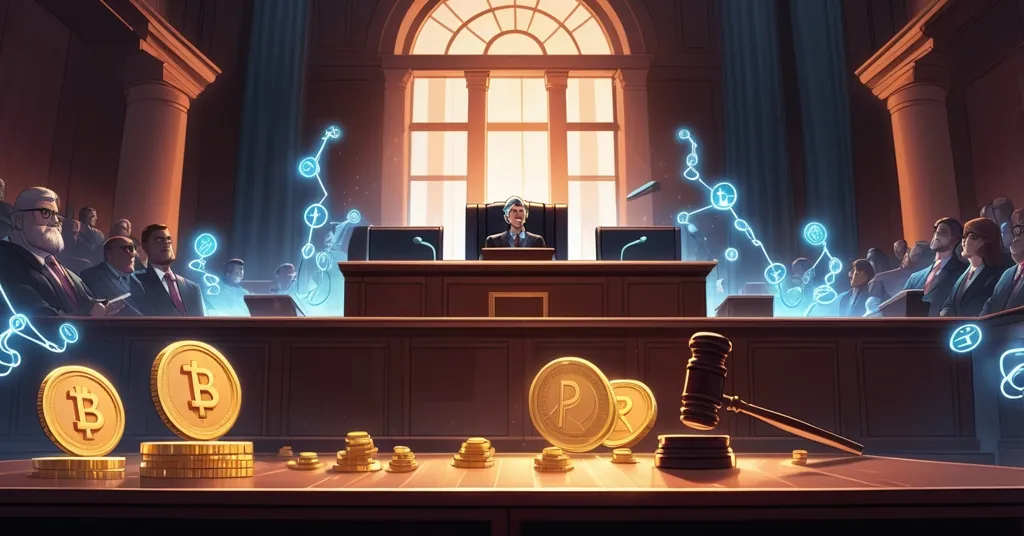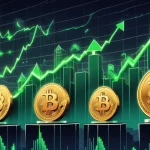Ripple vs SEC Case Nears End: Judge Torres Letter and XRP Price Surge Hint at Resolution

Ripple vs SEC Lawsuit Nears Finish Line: Judge Torres Letter and XRP Price Surge Signal Endgame
The protracted legal showdown between Ripple and the U.S. Securities and Exchange Commission (SEC) is finally approaching its conclusion, with a recent letter to Judge Analisa Torres marking a significant procedural step. As the crypto world holds its breath, XRP’s price has spiked nearly 6% in just 24 hours, reflecting market optimism—but the road ahead for Ripple, altcoins, and blockchain innovation remains fraught with uncertainty.
- Letter to Judge Torres requests removal of a key witness, hinting at case wrap-up.
- Ripple and SEC drop appeals, paving the way for resolution after nearly four years.
- XRP surges 6% amid legal developments, with trading volume up 23%.
Latest Developments in Ripple vs SEC Battle
For those who’ve been tracking the Ripple vs SEC saga since its start in December 2020, the central issue has always been whether XRP, Ripple’s native cryptocurrency, qualifies as a security under U.S. law. Think of a security like a stock or bond—if XRP is classified as one, Ripple would be subject to the same stringent regulations as public companies, potentially hamstringing its operations and setting a chilling precedent for other crypto projects. A partial win in July 2023, when Judge Torres ruled that certain XRP sales didn’t constitute securities offerings, offered a glimmer of hope. Yet, the legal grind has persisted with penalties, injunctions, and appeals keeping Ripple in limbo.
Now, a fresh update has emerged. A recent letter to Judge Torres from Andrew Kunsak of Sidley Austin LLP requests the removal of an investment banker declarant from the court docket—a formal list of actions or cases in a legal proceeding. This unnamed witness, involved since August 2023, provided expert testimony and worked to safeguard stakeholder confidentiality. As Kunsak noted,
“The confidentiality of their testimony is not an issue being appealed.”
Their removal suggests that their role in the evidence phase is done, potentially indicating that the case is in its final stages. Why does this matter? Confidentiality in such high-stakes cases protects sensitive business data, and clearing this hurdle without appeal means one less snag in wrapping things up. Interestingly, Kunsak is set to leave Sidley Austin LLP soon, with no other firm lawyers representing the witness moving forward—a minor detail, but in a case this intricate, every piece counts.
In parallel, Judge Torres recently rejected a motion for an indicative ruling, a legal tool that could have signaled how she might rule on lifting an injunction and cutting the civil penalty to $50 million following an SEC settlement proposal. Simply put, an indicative ruling is a judge’s “what if” preview to aid settlements, and her denial shows she’s not ready to let Ripple off with a discounted slap on the wrist. Still, there’s a major breakthrough: both Ripple and the SEC have withdrawn their appeals in the 2nd Circuit Court. This mutual stand-down is the strongest sign yet that this nearly four-year quagmire might finally end, lifting a suffocating burden off Ripple’s shoulders.
XRP Market Reacts with Optimism—But Is It Warranted?
The market isn’t waiting for the gavel to drop to show its hand. In just 24 hours, XRP’s price jumped nearly 6%, peaking at $2.59 and settling at $2.56 as of the latest figures, with a daily low of $2.41. Trading volume also spiked by 23%, a clear signal that traders are piling in, betting on a positive outcome. For context, this isn’t XRP’s first rodeo—after the July 2023 ruling, it saw similar short-term pumps, only to cool off later. Compared to its all-time high of over $3 in 2018, it’s still got ground to cover, and legal wins don’t guarantee lasting value. The current surge might reflect retail hype more than institutional confidence, given the rapid volume uptick. Crypto markets are a notorious rollercoaster, and while the numbers grab headlines, a quick spike can just as easily flip to a crash if the buzz fades. Long-term, XRP’s worth hinges on real-world adoption, not just courtroom drama.
Ripple’s Vision: Building the Internet of Value
Amid the legal noise, Ripple’s CEO Brad Garlinghouse is ready to turn the page.
“We’re closing this chapter once and for all, and focusing on what’s most important – building the Internet of Value.”
For the unacquainted, the Internet of Value is Ripple’s bold dream of a global financial network where value—be it money, assets, or digital tokens—flows as effortlessly as data does on today’s internet. Through RippleNet, powered by XRP, banks and institutions can settle cross-border transactions in seconds for pennies, compared to the days and hefty fees of traditional systems like SWIFT. It’s a compelling pitch to disrupt a broken financial pipeline, where sending money overseas often feels like mailing a letter in the age of email.
But let’s not get starry-eyed. Adoption remains a steep hill to climb—many traditional institutions are wary of crypto’s volatility and regulatory gray areas. Even with legal hurdles clearing, Ripple must prove its tech can win over skeptics in a sector notorious for resisting change. Still, Garlinghouse’s pivot from litigation to innovation echoes the disruptive spirit we root for in this space, even if Ripple’s more centralized model differs from Bitcoin’s raw, untamed ethos.
Ripple’s Fight: A Mirror for Crypto’s Regulatory Future
Zooming out, this isn’t just Ripple’s war—it’s a battleground for how decentralized tech will be governed. Bitcoin, often crowned as crypto’s untouchable king, enjoys a commodity classification in the U.S., shielding it from the securities label that haunts altcoins like XRP. As Bitcoin maximalists, it’s easy to scoff and say, “Let the altcoins burn.” After all, Bitcoin’s decentralized DNA and early-mover status make it less of a regulatory target. But let’s play devil’s advocate: if the SEC can grind a heavyweight like Ripple into the dirt for years, what’s stopping them from swinging their sledgehammer at other innovative projects? Cardano, Solana, and even Ethereum have faced similar scrutiny, hinting at a pattern of overreach that could choke blockchain progress across the board.
The Ripple case underscores a brutal truth—regulatory clarity in the U.S. is a mess. While the July 2023 ruling offered a lifeline, the absence of comprehensive crypto legislation keeps the industry on edge. Compare this to places like the EU, with frameworks like MiCA, or Singapore’s progressive stance, and it’s clear the U.S. risks lagging behind. Proposed bills like the FIT21 Act aim to define digital assets better, but until they pass, every altcoin is a potential lawsuit waiting to happen. Could the next SEC target be a project you’re backing? For us champions of decentralization, Ripple’s struggle is a stark reminder: freedom in finance isn’t won without a fight.
Why Bitcoin Fans Should Care About Altcoin Drama
Even if you bleed Bitcoin orange, dismissing altcoin battles is shortsighted. Sure, Bitcoin sidesteps much of this heat, but a hostile regulatory landscape for altcoins can ripple—yes, pun intended—through the broader ecosystem. Stifling projects like Ripple could slow the very innovation that pushes decentralized finance forward, a movement Bitcoin itself benefits from. Besides, platforms like Ripple tackle niches Bitcoin doesn’t aim to touch. Cross-border payments, for instance, are a slog in legacy finance, and RippleNet’s solutions, if proven, could validate blockchain’s practical power beyond Bitcoin’s store-of-value narrative.
As proponents of effective accelerationism, we’ve got to tip our hats to any tech shaking up the status quo, whether it’s Ethereum’s smart contracts or Ripple’s payment rails. That said, let’s keep it real—XRP’s centralized roots make it a regulatory lightning rod in ways Bitcoin’s design avoids. Legal wins are nice, but Ripple’s future depends on proving utility, not just dodging bullets. No amount of courtroom swagger substitutes for banks actually using XRP at scale.
Key Takeaways and Questions on Ripple’s Legal Saga
- What’s the latest on the Ripple vs SEC lawsuit?
A letter to Judge Torres requesting a key witness’s removal from the docket, coupled with both Ripple and the SEC dropping appeals, suggests this four-year legal clash is nearing its end. Judge Torres’ denial of a reduced penalty keeps the tension, but resolution feels closer than ever. - How is XRP’s price responding to the legal updates?
XRP soared nearly 6% in 24 hours, hitting $2.59 and trading at $2.56, with volume up 23%. While this reflects optimism over a potential legal victory, such rapid XRP market movements often attract speculative trading—real value depends on adoption. - Why does this case matter for cryptocurrency regulation?
It’s a litmus test for SEC crypto regulation in the U.S. Ripple’s partial 2023 win offers hope for altcoins, but without clear laws, uncertainty persists—unlike Bitcoin’s safer commodity status, many projects remain vulnerable. - Should Bitcoin maximalists care about Ripple’s legal fight?
Yes. Harsh SEC stances on altcoins could dampen blockchain innovation, impacting the ecosystem Bitcoin thrives in. Even if Bitcoin is insulated, a strangled altcoin space slows the decentralized revolution we fight for. - What’s Ripple’s ‘Internet of Value’ vision after the lawsuit?
It’s a blockchain-driven network for instant global value transfer, targeting cross-border payments via RippleNet and XRP. This Ripple blockchain innovation mirrors crypto’s disruptive goals, even if its centralized approach contrasts with Bitcoin’s path. - Is the XRP price surge momentum or mere hype?
Likely both. Legal news fuels optimism in XRP price analysis, but quick 6% jumps and volume spikes often draw speculators. Sustainable growth rests on fundamentals like partnerships, not just fleeting courtroom cheers. - What role should altcoins like XRP play in a Bitcoin-led future?
Altcoins can fill gaps Bitcoin doesn’t address, like Ripple’s focus on fast, cheap payments versus Bitcoin’s strength as a decentralized store of value. While Bitcoin remains the gold standard, niche utility from projects like XRP can push the broader mission of financial freedom—provided they survive the regulatory gauntlet.
Ripple’s legal odyssey is more than a headline—it’s a gritty testament to the crypto industry’s resilience and the regulatory minefield it navigates. As this chapter closes, the fight for a decentralized financial future burns on, with Ripple’s persistence and XRP’s market pulse proving this space won’t bow easily. For us at Let’s Talk, Bitcoin, it’s about cutting through the noise: celebrate the breakthroughs, call out the pitfalls, and demand clear rules over endless lawsuits. The road to reshaping finance is messy, but damn if it isn’t worth the battle.



